Starting a web design business in 2025 looks more promising than ever.
Whether you’re a seasoned designer with years of tech experience or just setting out to build your agency, the opportunities are immense.
From local bakeries craving modern makeovers to SaaS startups aiming for high-conversion landing pages, businesses everywhere are investing in professional web design.
It’s not just about crafting beautiful websites. It’s about building businesses that succeed online.
Ready to turn your passion into profit? Let’s get to know the proven roadmap.
- Scope of a Web Design Business
- 1- Define Your Niche
- 2- Choose Your Services
- 3- Set Up Your Business
- 4- Setting Up Business Operations
- 5- Brand and Portfolio Building
- 6- Get Clients and Market Your Business
- 7- Scale Your Business
- 8- Supercharge Your Web Design Business With ZipWP
- Start Your Web Design Business Today
Pro Tip
Setting up a web design business from scratch can feel overwhelming. But what if you had a tool that did most of the heavy lifting for you?
Imagine building a professional website in minutes, pitching clients with real-time previews, and managing everything from hosting to maintenance – all from one platform.
Stay tuned, because later we’ll show you how ZipWP makes it possible!
Scope of a Web Design Business
The web design industry is booming and the numbers back it up:
- Over 1.5 billion websites exist, but only 200 million are actively maintained
- Around 252,000 new websites are created daily.
- 71% of registered small businesses have a website.
- WordPress powers over 40% of all websites worldwide.
- The global web design market is expected to grow from $61.23 billion in 2025 to $92 billion by 2030
One key insight: It takes just 0.05 seconds for visitors to decide whether to stay on a website.
Poor design? They’re gone. This shows how vital professional web design is in today’s competitive landscape.
Real-world success stories highlight the potential of a web design business. For instance, Jeff from Huemor started as a freelance designer and now runs a $3 million agency.
Similarly, Jasmine transitioned from an unfulfilling job to a successful design business. Proving that with the right strategy and mindset, your passion can become a thriving career.
Let’s begin your entrepreneurial journey with finding a niche.
1- Define Your Niche
Finding the right niche is the foundation of your web design business.
Specializing in a specific area helps you become highly efficient and effective. It allows you to charge premium rates and build credibility faster.
Here’re some of the key benefits:
- Reduced competition: Stand out as an expert.
- Higher quality referrals: Niche clients refer more consistently.
- Premium pricing: Specialists command higher fees.
- Targeted marketing: Easier to craft messages that resonate.
- Stronger reputation: Build authority faster.
How To Choose Your Niche
Combine your skills, interests, and market demand to find the perfect fit.
Here’s how:
- Identify your strengths: Are you good at eCommerce, UX/UI, or branding?
- Research market trends: Use tools like Google Trends and Ahrefs.
- Use past successes: Reflect on projects you enjoyed and did well.
- Balance passion and profit: Ensure there’s client demand.
Hot Niches To Consider (2025 and Beyond)
If you’re still thinking about finalizing a niche, here are some of the hottest niches to focus on right now.
| eCommerce and online stores | Shopify and WooCommerce solutions. |
| AI-powered UX | Integrating AI features into modern designs. |
| Accessibility and compliance | ADA-compliant designs for healthcare and education. |
| Personal brands and influencer | Sleek, professional online presence |
| Local Businesses | Mobile-friendly sites for small shops and services. |
Don’t worry too much about it. Your niche will usually come together as you figure out which clients or projects you enjoy and do well with.
Also keep in mind, your niche isn’t permanent. You can always change it or try new things – it’s your business after all!
2- Choose Your Services
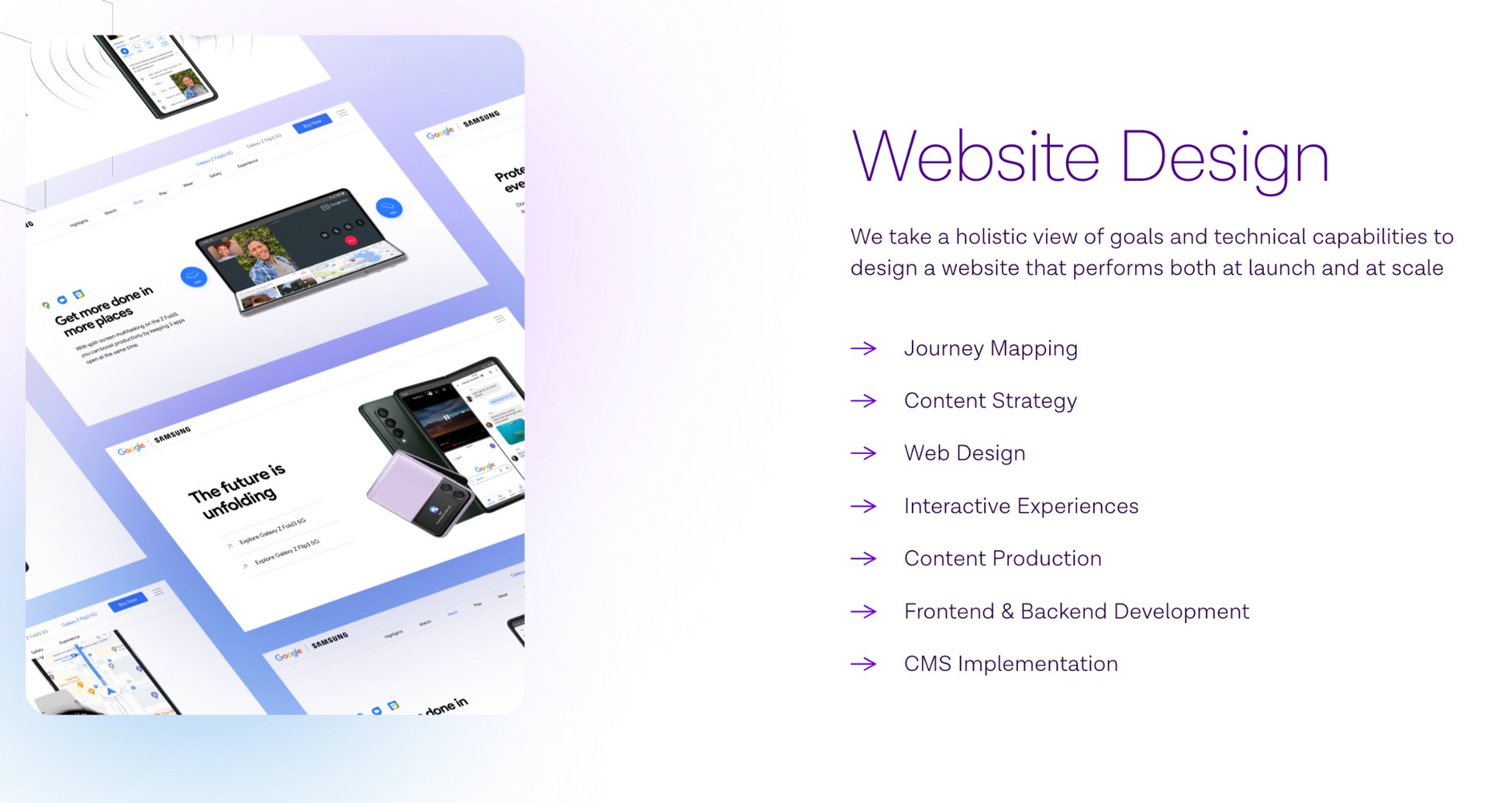
Once your niche is clear, decide what services you’ll offer. The right ones can set you apart and keep the cash flowing, so it’s worth taking the time to get it right.
Start by doing a little research to see what’s hot in the industry. Visit competitor’s websites or forums like Reddit and see what people are talking about.
Even chatting with friends who work in the field can give you valuable insights.
Once you’ve got a good sense of what’s trending, it’s time to build your own list of offerings.
Here’re some in-demand services.
- Website design and development: Professional sites for businesses of all sizes.
- UX and UI design: Creating intuitive, user-friendly interfaces.
- Website accessibility: Websites with accessibility standards for users with special needs.
- SEO services: Improving site visibility and ranking.
- Content creation and marketing: Engaging content that drives traffic.
- eCommerce solutions: High-conversion online stores.
- Website maintenance and support: Regular updates and security checks.
- Managed hosting and domain services: Bundle hosting and domain management for consistent recurring income.
- Graphic design and branding: Build visual identities. From logos to social media graphics, make clients look professional and consistent.
Pro Tip:
One-time services like website builds or branding give you big paychecks upfront, but recurring services like hosting or SEO keep cash flowing month after month.
Balance both to create a stable, predictable income that grows over time.
3- Set Up Your Business
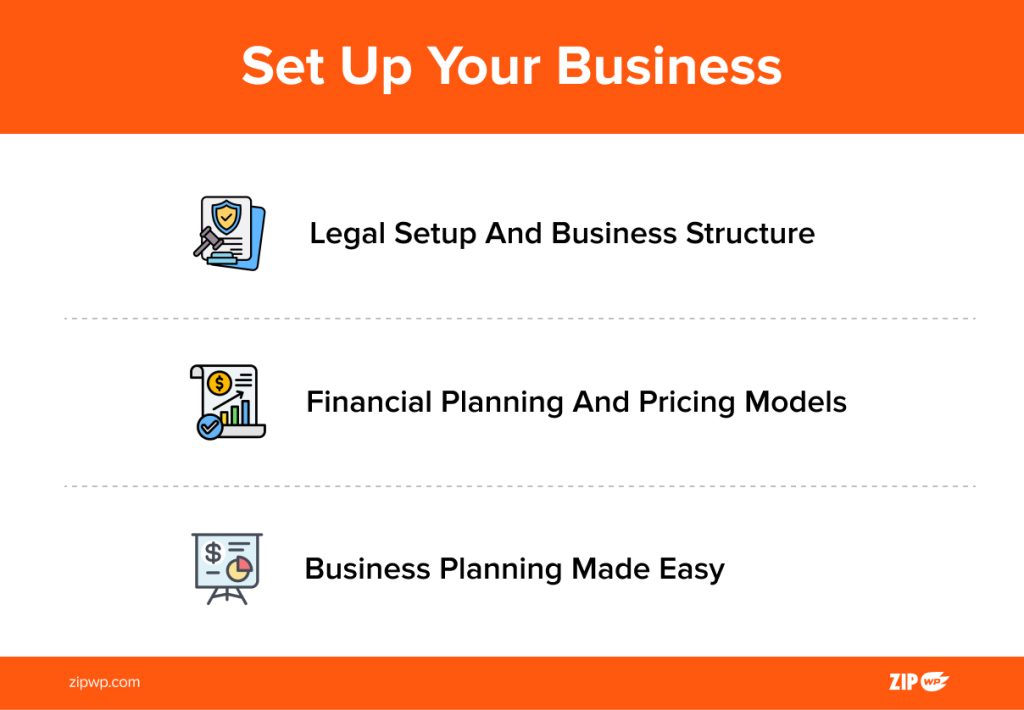
Getting your web design business off the ground involves more than just designing websites.
You need a solid foundation to build upon.
This includes choosing the right legal structure, creating a practical business plan, and setting up smart financial strategies.
Legal Setup and Business Structure
Choose the right business structure to protect your assets and simplify taxes:
- Sole Proprietorship: Easy but lacks liability protection.
- LLC (Limited Liability Company): Combines simplicity with liability protection.
- Corporation: Suitable for larger teams and investment.
Choosing the right structure will give your business credibility and protect you from unnecessary risks.
Remember, when naming your business, choose a name that’s memorable and easy to pronounce
Just as important, secure a domain that matches your business name to build a consistent and professional brand presence.
Business Planning Made Easy
A business plan is your roadmap. It helps you set clear goals, identify your ideal clients, and craft a marketing strategy.
Your plan should cover:
- Vision and goals: Define where you want your business to go.
- Target market: Know your ideal clients and understand what they need.
- Service offerings: Clearly list what you provide and how you’ll price it.
- Marketing strategy: Outline how you’ll find and keep clients.
Having a plan not only keeps you organized but also boosts your confidence to move forward.
Financial Planning and Pricing Models
Calculate your costs and figure out your hourly rate. Set a competitive pricing model that covers your expenses and leaves room for profit:
- Hourly pricing: Ideal for short-term projects.
- Project-based pricing: Fixed fees for defined tasks.
- Retainers: Ongoing services with consistent income.
Setting your rates and choosing the right model helps keep your income steady.
Grab Your Free Business Setup Guide
Feeling overwhelmed? Don’t worry, we’ve got your back.
Download the Business Setup Guide with easy-to-fill templates that cover legal structure, business planning, and pricing models.
It’s your one-stop solution to getting set up the right way!
4- Setting Up Business Operations
Alright, now that you’ve got your business plan and pricing strategy sorted, it’s time to get practical by setting up your business operations.
This is where the real magic happens, from creating stunning websites to keeping your workflow smooth and efficient.
Let’s make sure you’re set up for success right from the start.
Create a Productive Workspace
Your workspace needs to be comfortable and distraction-free, whether you’re working from home or in a coworking space.
At home, set up a cozy spot with a comfy chair, sturdy desk, and ideally a dual-monitor setup for extra productivity. Invest in a high-performance laptop or desktop to handle design software.
If you’re at a coworking space, make sure it offers high-speed internet, dedicated desks, and networking areas to keep you productive and connected.
Equip Yourself With the Right Tools
The right tools can make or break your workflow.
Here’s what you need to make your business run like a well-oiled machine:
- Design and development tools: ZipWP, Figma, Adobe XD
- Project management: Clickup, Trello, Asana
- Client communication: Slack, Zoom, Calendly
- Financial and invoicing: QuickBooks, Wave, HoneyBook
- SEO and performance monitoring: Ahrefs, SEMrush, Moz
Streamline Your Workflow
Efficiency is key when juggling multiple projects. Automate repetitive tasks and create templates to save time.
Here are a few tips to keep things running smoothly:
- Automate client onboarding: Use tools like OttoKit or Zapier to link booking apps with your project management software.
- Canned responses: Prepare standard replies for common questions to save time.
- Automate backups: Use tools like ManageWP to keep client websites secure and updated without manual effort.
Document Your Processes
Creating standard operating procedures (SOPs) ensures consistency and saves you tons of time.
Documenting routine tasks like client onboarding, project initiation, and maintenance means you can easily delegate or train new team members as your business grows.
5- Brand and Portfolio Building
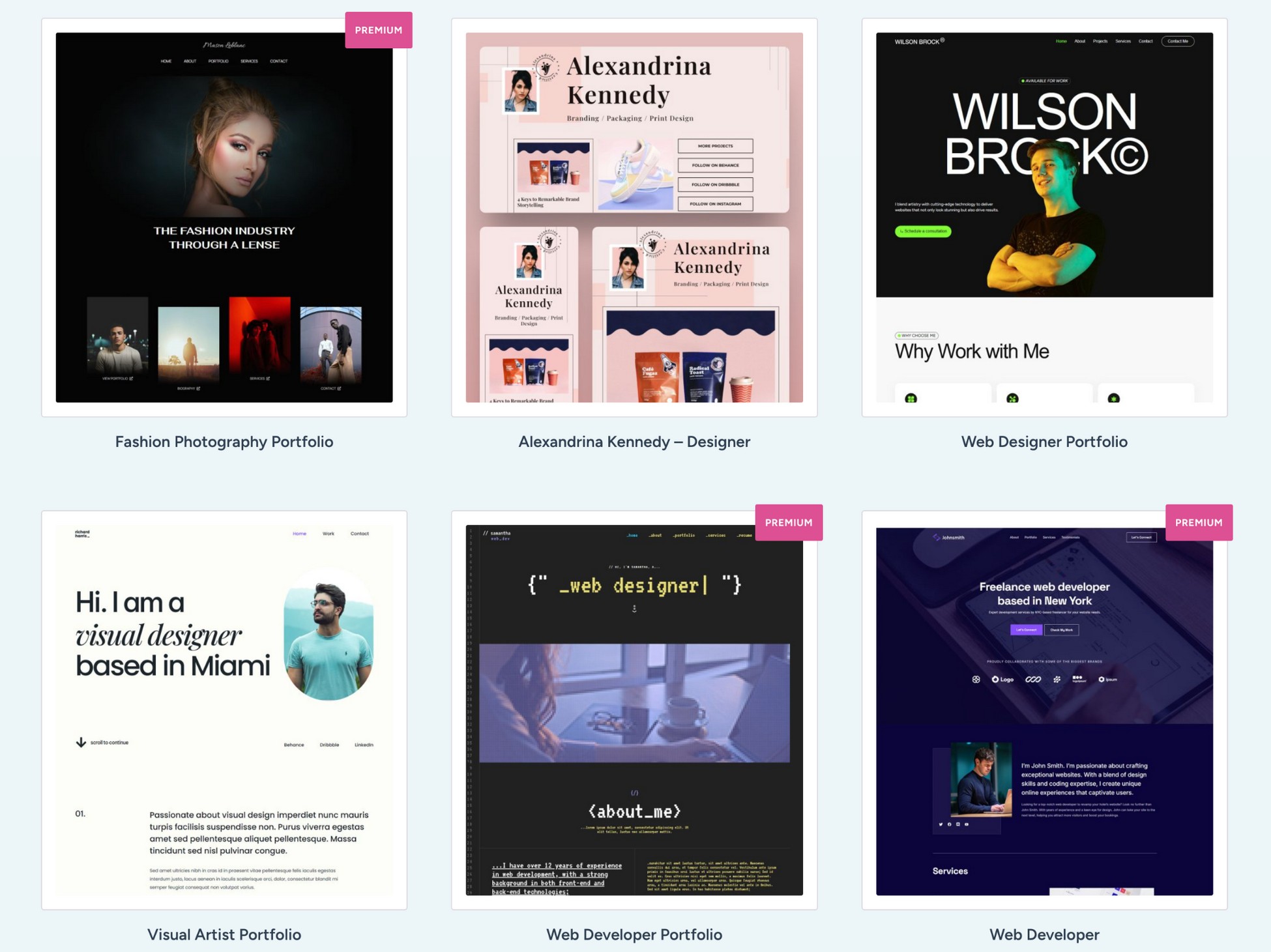
Your brand and portfolio should work together seamlessly to make a powerful impression.
Your brand identity is how clients perceive you, your personality, your style, and your vibe.
Your portfolio, on the other hand, is your digital storefront. It’s where your brand comes to life and showcases what you can do.
Note: We’ll use one of Astra theme’s starter templates, Web Designer Portfolio, to showcase different sections here.
Crafting Your Brand Identity
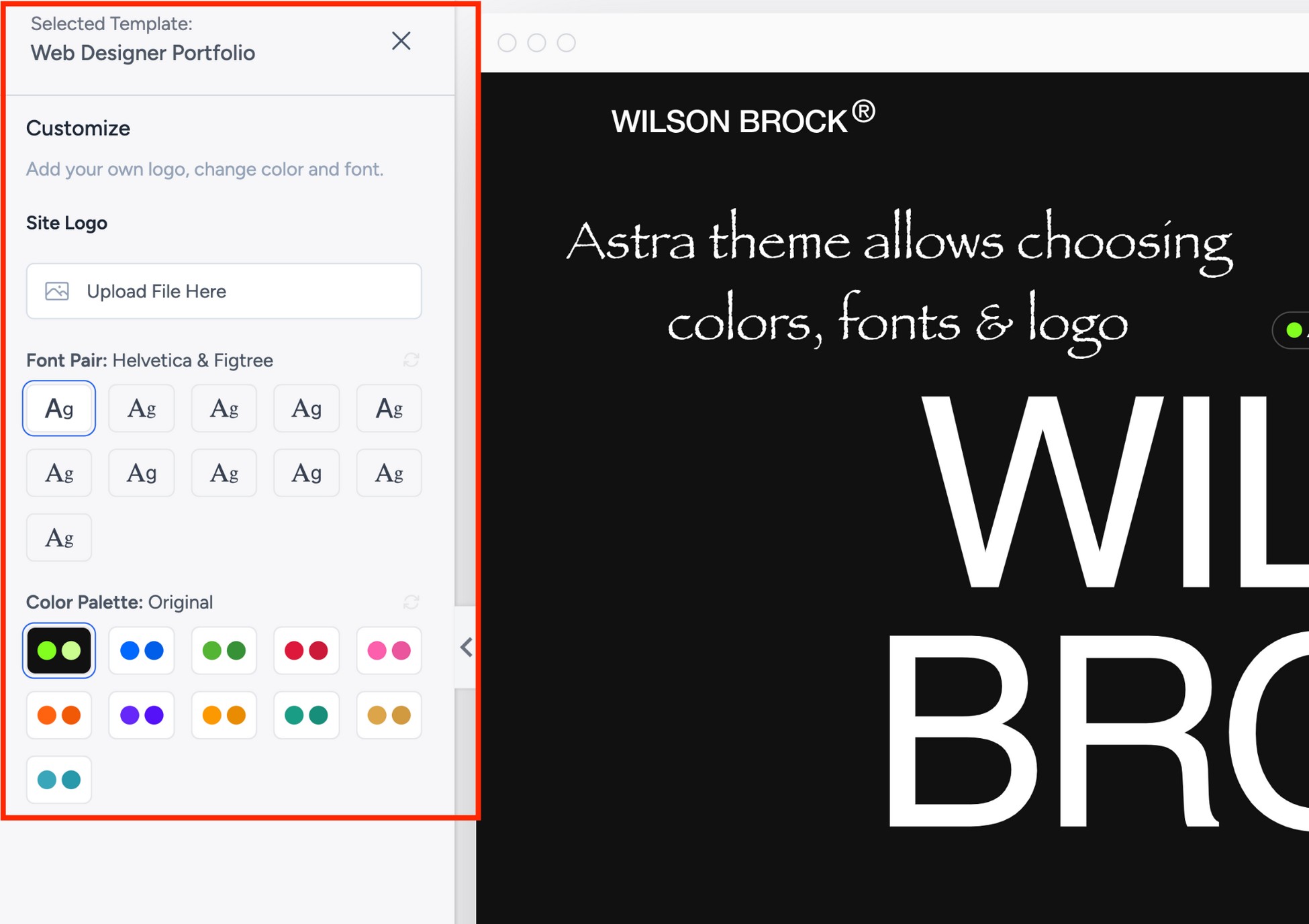
Start by defining a brand voice that reflects who you are, whether it’s professional, approachable, or bold.
Your brand’s personality should guide your visual elements, including your logo, color scheme, and typography.
Here’s how to make it cohesive:
- Logo: Keep it simple, memorable, and versatile – something that looks great on your website, social media, and business cards.
- Color scheme: Choose colors that align with your brand’s vibe. For example:
- Bold and modern: Vibrant colors with clean, sans-serif fonts.
- Professional and trustworthy: Navy, gray, or gold with classic serif fonts.
- Friendly and approachable: Soft colors and rounded, playful typography.
- Typography: Stick with one or two fonts to maintain consistency and reinforce your brand’s tone.
Your brand identity should be consistent across every platform – website, social media, or marketing materials. This uniformity builds recognition and trust.
Nailing Your Elevator Pitch
Your elevator pitch is a quick, punchy way to introduce your business. It should clearly state what you do, who you help, and the value you bring.
Keep it conversational and avoid jargon. Practice saying it naturally so it feels effortless when you’re networking or introducing yourself to potential clients.
Create a Portfolio Website
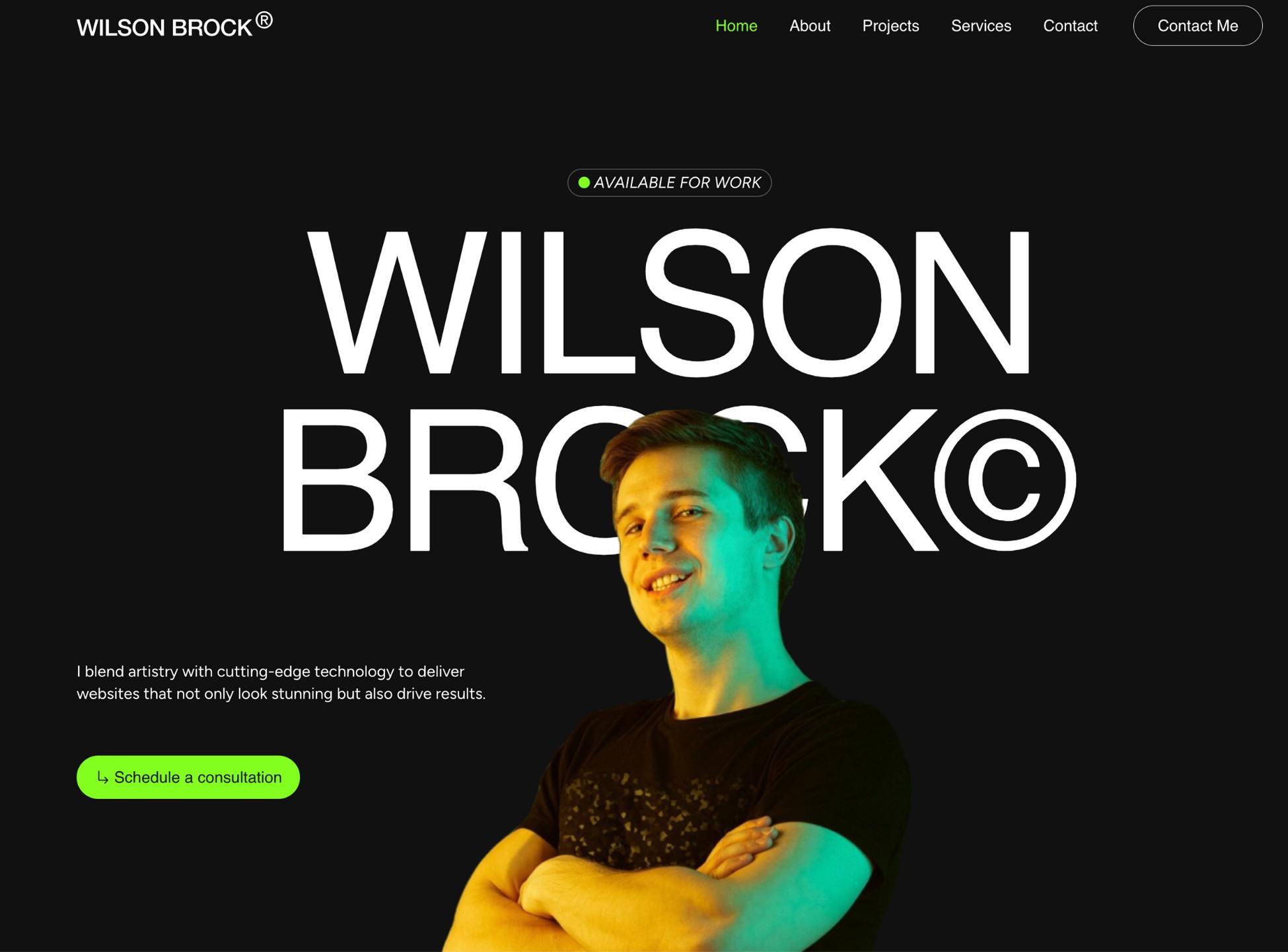
Your portfolio website is your digital storefront, showcasing not just your work but your brand identity in action.
Make it visually consistent with your branding, and focus on storytelling to connect with potential clients.
Structure each project with these key elements:
- Client and challenge: Briefly explain the problem you solved.
- Your approach: Describe your design process and highlight your creativity.
- Results: Showcase measurable outcomes, like increased traffic or higher conversion rates.
Keep the design clean and easy to navigate. Use high-quality images and well-written descriptions to make a strong impression.
Use Testimonials To Build Trust
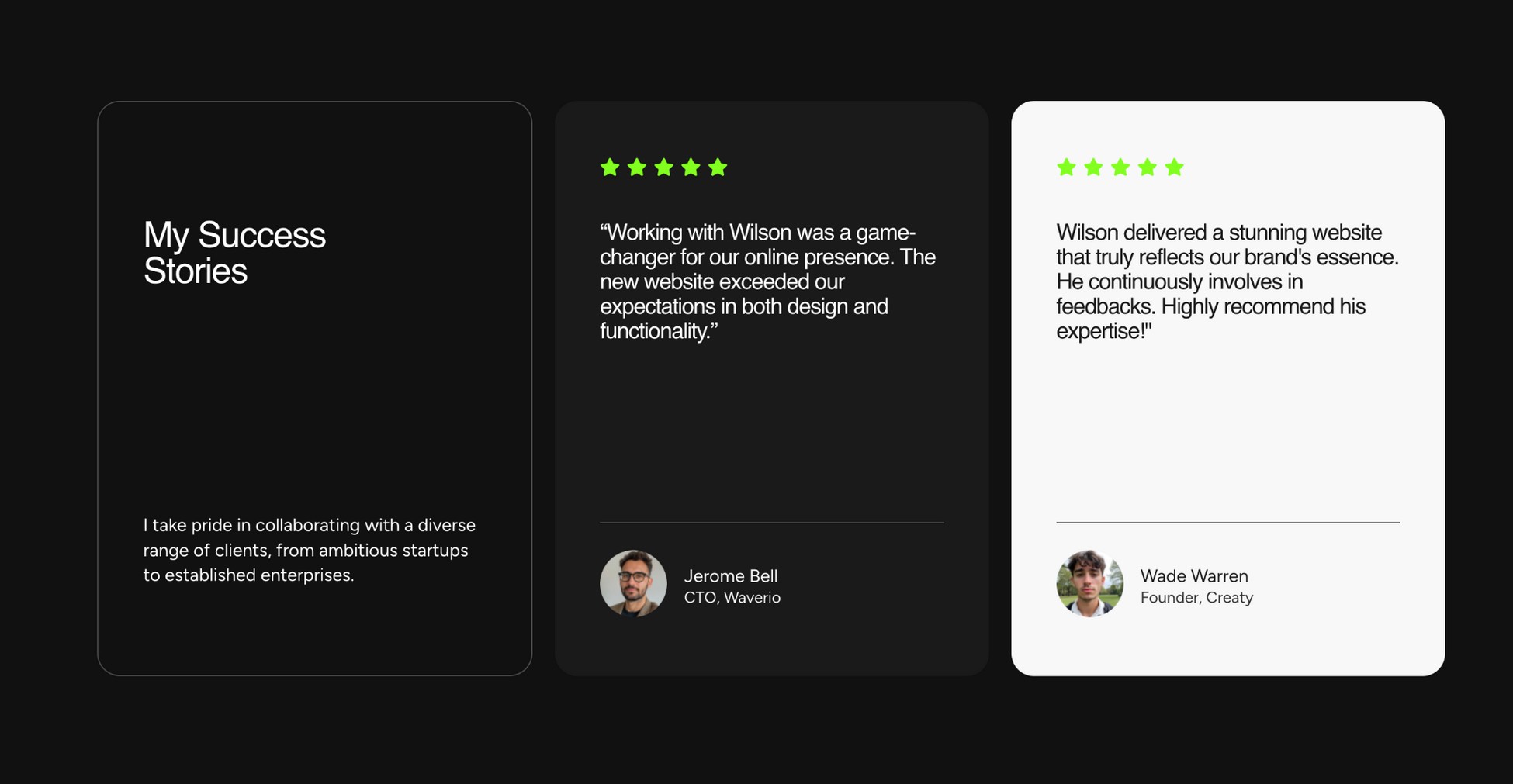
Collect feedback from clients to display on your site. A strong testimonial highlights the problem you solved and the value you delivered.
Keep Your Brand Consistent
Your brand identity shouldn’t change from one platform to another. Whether it’s your website, social media, or email templates, everything should feel cohesive.
Create a simple brand guide to outline your logo usage, color palette, typography, and brand voice.
This will ensure your messaging stays consistent no matter where clients find you.
Don’t Forget the SEO Basics
Your portfolio won’t be much help if no one can find it. Make sure your site is optimized for search engines.
- Include your main keyword in the meta title and description.
- Use descriptive image alt text for accessibility and SEO.
- Regularly update your blog with niche content to attract organic traffic.
Writing blog posts on topics your potential clients care about not only boosts your SEO but also shows your expertise.
For instance:
- “5 Tips to Improve Your Website’s Loading Speed”
- “How to Create User-Friendly E-commerce Sites”
Call To Action: Let’s Work Together

Once visitors are impressed with your work, make it easy for them to take the next step.
Use action-driven CTAs like:
- “Get Your Free Quote”
- “Let’s Build Your Dream Website”
- “Schedule Your Consultation”
Include a simple contact form that asks for just enough information without being overwhelming. Integrate scheduling tools like LatePoint to make booking calls quick and easy.
6- Get Clients and Market Your Business
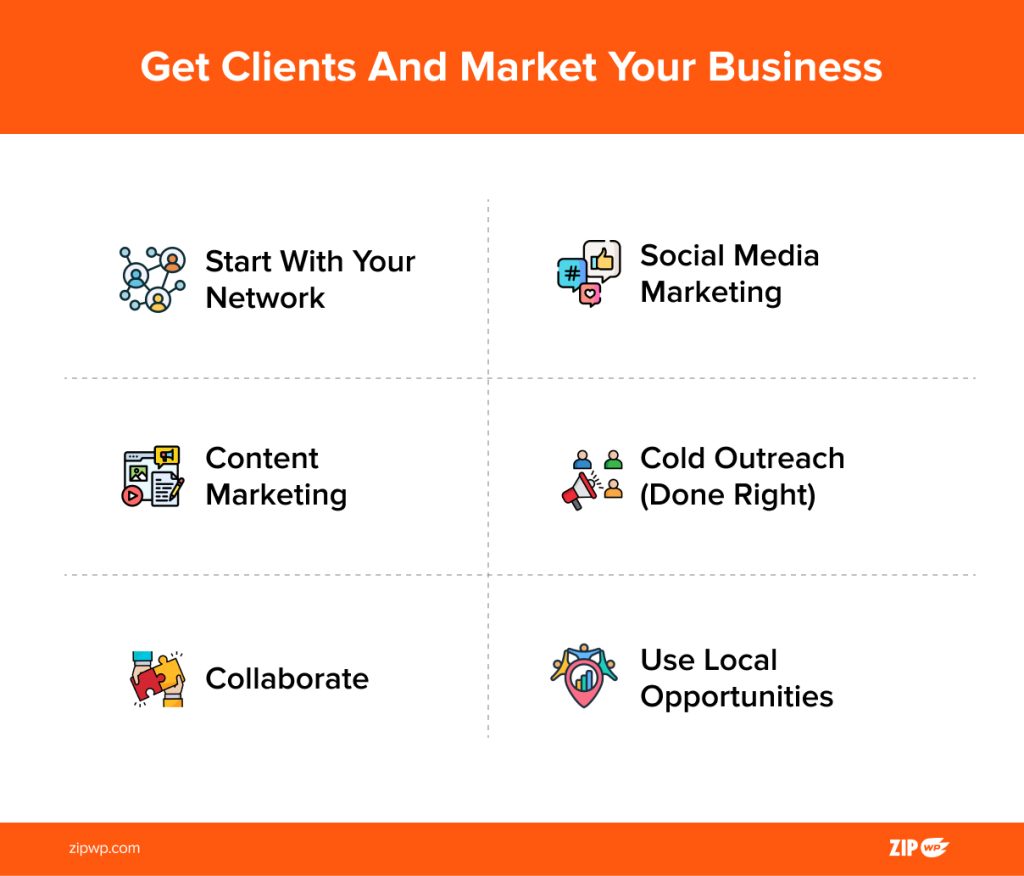
Getting clients and marketing your services go hand in hand. The goal is simple – put yourself out there, build relationships, and showcase your expertise without feeling like a pushy salesperson.
Use these strategies to build relationships and attract leads.
Start With Your Network
Your first clients are closer than you think. Reach out to friends, family, and past clients. Let them know about your new business and ask for referrals.
Social Media Marketing
Share project updates, client success stories, and behind-the-scenes glimpses on social platforms.
- Post before-and-after comparisons on Instagram.
- Write detailed case studies on LinkedIn.
- Share quick design tips on Twitter.
- Use short video tutorials on YouTube.
Content Marketing
Blogging and video content are goldmines for showcasing your expertise. Create blogs and videos that position you as an expert.
Share insights, how-to guides, and case studies to attract organic traffic.
Cold Outreach (Done Right)
Cold outreach works when done thoughtfully. Take the time to research each business and personalize your pitch.
Mention something specific about their current website and how you can improve it.
Collaborate
Team up with marketing agencies, branding experts, or SEO consultants who might need web design services.
Offer to collaborate on projects or refer clients to each other.
Use Local Opportunities
Set up a Google Business Profile and make your services visible to the community.
Attend local events, sponsor community meetups, or even offer a free consultation to a few local businesses.
7- Scale Your Business
Once you have a steady flow of clients, think about scaling up. Diversifying your revenue streams is a great way to build financial stability.
Use these proven strategies to grow your business.
- Offer online courses and workshops: Package your skills into teachable formats and sell them on platforms like Udemy or Teachable.
- Productize your services: Create fixed-price packages for common services to make client decisions easier.
- Hire and delegate: Start with freelancers for small tasks, then gradually build a core team as your business grows.
- Sell templates: Sell predesigned website templates on marketplaces to make extra revenue.
- Keep learning and improving: Make continuous learning a habit by setting aside time each week to explore new techniques, tools, or industry insights.
8- Supercharge Your Web Design Business With ZipWP
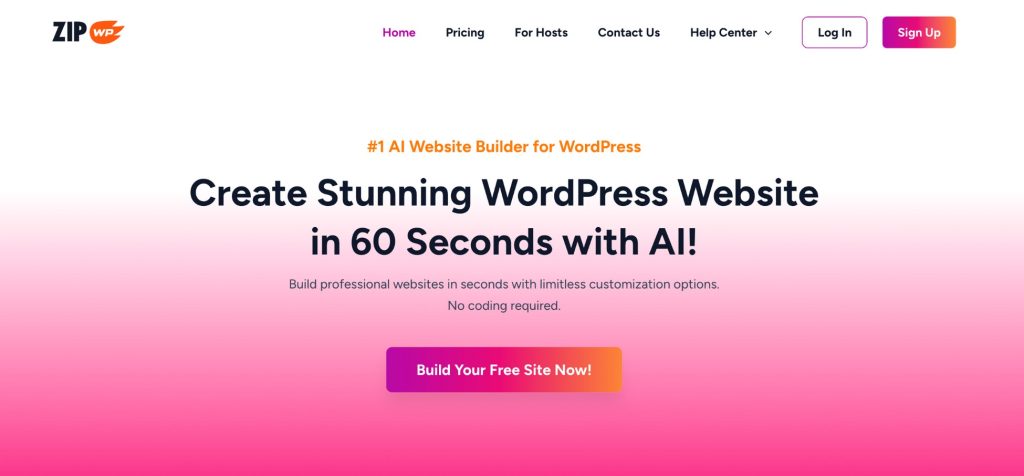
Remember when we mentioned ZipWP? It’s the game-changer that makes life easier for you as an entrepreneur.
When you’re building a web design business, time is money. You need tools that make your process efficient and seamless without sacrificing quality.
That’s where ZipWP comes in. It’s a revolutionary platform designed to take your web design business to the next level.
Whether you’re just starting out or looking to scale, ZipWP empowers you to:
- Build professional websites in minutes: Create stunning, client-ready websites in record time and get instant feedback. This way, you close deals faster than ever.
- Real-time client collaboration: Add clients to your project team and let them see the progress in real time. This way, you maintain seamless communication and build trust.
- Sandbox environment for testing: No need to test features on live sites. Safely test updates, plugins, or new features in a sandbox environment before applying them to the main site.
- Effortless portfolio creation: Showcasing your work has never been easier. Use ZipWP to build impressive portfolio websites that wow potential clients and convert visitors.
- Sell prebuilt templates: Create blueprints and sell them on marketplaces to make extra money. The ZipWP dashboard tracks how many times your blueprint has been used, so you know what’s working.
You’re not just building websites, you’re building a sustainable business with ZipWP.
From pitching clients to delivering projects faster than ever, ZipWP is your ultimate partner in web design success.
Ready to see ZipWP in action? Watch this quick tour and discover how it can supercharge your web design business!
Build your web design business with ZipWP!
Start Your Web Design Business Today
Building a web design business in 2025 isn’t just about creating stunning websites. It’s about mastering your niche, building a memorable brand, and leveraging smart operations.
But let’s be honest – getting everything set up, finding clients, and delivering projects can feel overwhelming.
That’s where using the right tools makes all the difference. One tool that stands out is ZipWP.
It helps you build professional websites faster and manage projects more efficiently, giving you more time to focus on growing your business.
Whether you’re just starting out or looking to scale, remember that consistency, passion, and smart choices are your biggest assets. Keep experimenting, keep learning, and stay resilient.
You’ve got what it takes to thrive. Now go build that dream business!
Join 931,900 Subscribers
Disclosure: This blog may contain affiliate links. If you make a purchase through one of these links, we may receive a small commission. Rest assured that we only recommend products that we have personally used and believe will add value to our readers. Thanks for your support!

Recommended Articles
Empower Your Influence & Content With ZipWP Blueprints!
Let People Test Drive Your WordPress Products with ZipWP Blueprints!